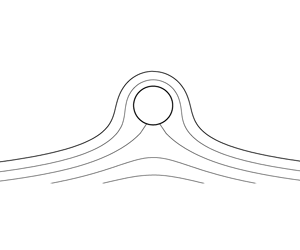Article contents
Free-surface gravity flow due to a submerged body in uniform current
Published online by Cambridge University Press: 29 November 2019
Abstract

The hydrodynamic problem of a body submerged beneath a free surface in a current is considered. The mathematical model used is based on the velocity potential theory with fully nonlinear boundary conditions. The integral hodograph method used previously in a simply connected domain is extended for the present problem to a doubly connected domain. Analytical expressions for the complex velocity and for the complex potential are derived in a rectangular region in a parameter plane, involving the theta functions. The boundary-value problem is transformed into a system of two integral equations for the velocity modulus on the free surface and for the slope of the submerged body surface in the parameter plane, which are solved through the successive approximation method. Case studies are undertaken both for a smooth body and for a hydrofoil with a sharp edge. Results for the free surface shape, pressure distribution as well as resistance and lift are presented for a wide range of Froude numbers and depths of submergence. It further confirms that at each submergence below a critical value there is a range of Froude numbers within which steady solution may not exist. This range increases as the submergence decreases. This applies to both a smooth body and a hydrofoil. At the same time it is found that at any Froude number beyond a critical value the wave amplitude and the resistance decrease as the body approaches the free surface. In these cases nonlinear effects become more pronounced.
JFM classification
Information
- Type
- JFM Papers
- Information
- Copyright
- © 2019 Cambridge University Press
References
- 9
- Cited by

